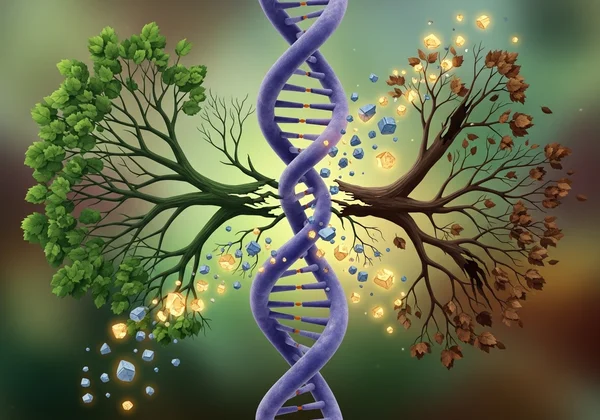Am I A Narcissist? Take Our Free NPD Test
The term "narcissist" is used frequently in conversations today, often to describe someone who seems self-absorbed or arrogant. However, understanding the clinical reality of Narcissistic Personality Disorder (NPD) goes far beyond these surface-level descriptions. Navigating its complexities can be challenging, whether you're grappling with your own traits or trying to understand a difficult relationship. This comprehensive guide is designed to empower you with clarity, shedding light on NPD's core definitions, symptoms, causes, and the diagnostic path.
This journey of understanding can be a crucial first step, whether you are questioning your own traits or trying to make sense of a relationship. For those seeking initial insights, a confidential screening tool can be an invaluable resource. You can begin to take our confidential NPD test to explore these traits in a safe, private setting.

What Exactly is Narcissistic Personality Disorder (NPD)?
Narcissistic Personality Disorder is a mental health condition characterized by a persistent pattern of grandiosity, a constant need for admiration, and a lack of empathy for others. This pattern of behavior is not just a personality quirk; it significantly impairs a person's ability to form and maintain healthy relationships and can cause distress in many areas of life, including work and social settings.
It's crucial to understand the difference between these clinical traits and moments of selfishness or high self-confidence that everyone experiences. NPD involves a pervasive and inflexible way of thinking and behaving that begins in early adulthood and remains stable over time, creating consistent challenges for the individual and those around them.
Defining Narcissistic Traits vs. Healthy Self-Esteem
A common point of confusion is the line between narcissistic traits and healthy self-esteem. Healthy self-esteem is rooted in a realistic appreciation of one's strengths and weaknesses. It allows for genuine confidence without devaluing others. In contrast, the grandiosity seen in NPD is often a fragile facade, masking deep-seated insecurities. An individual with high self-esteem can accept criticism, while someone with narcissistic traits may react with rage or contempt.
The Spectrum of Narcissism: A Brief Overview
It is helpful to view narcissism as existing on a spectrum. On one end, you have healthy self-confidence and ambition. As you move along the spectrum of narcissism, traits become more pronounced and problematic, potentially culminating in a clinical diagnosis of NPD at the far end. Not everyone with narcissistic traits has NPD, but understanding where certain behaviors fall on this spectrum can provide valuable context for self-reflection and relationship analysis. An am i a narcissist test can offer a preliminary look into these patterns.
The 9 DSM-5 Criteria for NPD: In-Depth Explanation
To be clinically diagnosed with NPD, an individual must meet specific criteria outlined in the Diagnostic and Statistical Manual of Mental Disorders (DSM-5-TR). A person must exhibit a pervasive pattern of grandiosity, need for admiration, and lack of empathy, indicated by five (or more) of the following nine NPD symptoms:
- A grandiose sense of self-importance.
- Preoccupation with fantasies of unlimited success, power, brilliance, beauty, or ideal love.
- A belief that they are "special" and unique and can only be understood by, or should associate with, other special or high-status people.
- A need for excessive admiration.
- A sense of entitlement.
- Interpersonally exploitative behavior.
- A lack of empathy.
- Envy of others or a belief that others are envious of them.
- Arrogant, haughty behaviors or attitudes.
Grandiosity & Sense of Entitlement: More Than Just Arrogance
At the heart of NPD lies grandiosity, an inflated sense of self-importance that is not supported by reality. This isn't just arrogance; it's a deep-seated belief in one's own superiority. This is often paired with a powerful sense of entitlement—an unreasonable expectation of especially favorable treatment or automatic compliance with their expectations. This can lead to frustration and anger when the world does not cater to their perceived special status.

A Profound Lack of Empathy and Interpersonal Exploitation
Perhaps one of the most damaging traits is a profound lack of empathy. This is the inability or unwillingness to recognize or identify with the feelings and needs of others. This emotional disconnect allows for interpersonal exploitation, where individuals with NPD may use others to achieve their own ends without guilt or remorse. Relationships become transactional, valued only for what they can provide. If these behaviors feel familiar, you can take our free NPD screening test to explore these signs further.
Fantasies of Unlimited Success, Power, & Ideal Love
Individuals with NPD often live in an internal world filled with fantasies of unlimited success, power, brilliance, or ideal love. They may believe they are destined for greatness, and this preoccupation can make their real-life achievements seem inadequate. This fantasy world serves as a coping mechanism, protecting their fragile self-esteem from the disappointments of reality.
Understanding the Causes & Development of Narcissistic Traits
There is no single cause of NPD. Like most personality disorders, it is believed to result from a complex interplay of genetic, biological, and environmental factors. Research continues to explore the exact mechanisms, but several key influences have been identified.
The Role of Genetics, Brain Chemistry, and Biology
Evidence suggests that genetics and biology play a role. Having a close relative with NPD may increase the risk of developing the disorder. Additionally, some brain imaging studies have shown differences in the brain structures of individuals with NPD, particularly in areas related to empathy and emotional regulation.
Environmental & Childhood Factors: Parenting and Trauma
Childhood factors are considered highly significant in the development of narcissistic traits. Inconsistent parenting and trauma can be major contributors. This can include excessive praise and pampering that fosters a sense of entitlement, or, conversely, severe criticism, abuse, or neglect that leads an individual to develop a grandiose persona as a defense mechanism against feelings of worthlessness.

Types of Narcissism: Grandiose vs. Vulnerable & Other Subtypes
While the DSM-5 provides one set of criteria, clinicians and researchers recognize that NPD can manifest in different ways. The two most widely discussed subtypes are grandiose and vulnerable narcissism. Understanding these distinctions can help in recognizing the more subtle presentations of the disorder.
The Overt (Grandiose) Narcissist: Characteristics & Impact
The overt, or grandiose, narcissist is the stereotypical presentation. They are often extroverted, arrogant, and openly entitled. They actively seek attention and admiration and are unafraid to boast about their accomplishments. Their self-importance is on full display, and they can be charming at first, though their exploitative nature often emerges over time.
The Covert (Vulnerable) Narcissist: Hidden Insecurities
The covert narcissist, also known as the vulnerable narcissist, is more subtle. On the surface, they may appear shy, insecure, or even victimized. However, they harbor the same grandiose beliefs and sense of entitlement. Their narcissism is expressed more passively, through manipulation, holding grudges, and a deep-seated belief that their talents are constantly overlooked.
How is Narcissistic Personality Disorder Diagnosed?
A formal diagnosis of NPD can only be made by a qualified mental health professional. It is a serious step that should not be taken lightly. However, understanding the process can demystify the path toward getting help and clarify the role of preliminary self-assessment tools.
The Clinical Assessment Process by Professionals
A clinical assessment for NPD is thorough and comprehensive. It involves structured interviews and psychological evaluations conducted by a psychologist or psychiatrist. The professional will compare the individual's long-term patterns of behavior and inner experiences against the strict criteria listed in the DSM-5-TR. They will also rule out other potential mental health conditions.
The Role of Self-Screening Tools
This is where self-screening tools come in. An online npd disorder test is not a diagnostic tool. Instead, it is a valuable first step designed for self-reflection. The confidential and free NPD screening tool available on our platform is based on DSM-5 standards to provide a reliable, preliminary insight into your traits. It helps you organize your thoughts and concerns, giving you a clearer picture to discuss with a professional if you choose. To try the free npd test, visit our homepage.
Your Journey to Understanding NPD & Next Steps
Navigating the complexities of Narcissistic Personality Disorder is a journey that begins with knowledge. Whether you see these traits in yourself or someone you care about, understanding the definitions, symptoms, and underlying causes is the first empowering step toward clarity and potential change. Remember, identifying traits is not a final judgment but an invitation to explore further.
This guide has provided a comprehensive foundation, but true insight comes from personal reflection. If you are ready to take the next step on your path to self-discovery, consider using a structured tool to guide your thoughts. Start your test now and gain confidential, instant insights into your personal traits.
Frequently Asked Questions About Narcissistic Personality Disorder
What is an NPD test, and how does it help?
An NPD test is a self-assessment questionnaire designed as a screening tool, not a diagnostic instrument. It helps you reflect on your behaviors and attitudes in relation to the widely recognized traits of Narcissistic Personality Disorder. It can provide a starting point for self-awareness and can be a useful summary to bring to a mental health professional.
What are the primary 9 signs of NPD to look for?
The primary 9 signs of NPD as listed in the DSM-5-TR are: a grandiose sense of self-importance, preoccupation with fantasies of success, belief in one's own uniqueness, a need for excessive admiration, a sense of entitlement, interpersonal exploitation, a lack of empathy, envy of others, and arrogant behaviors.
Do individuals with NPD know they are narcissistic?
This is complex. Some individuals with NPD have very little self-awareness and do not see their behaviors as problematic. Others may have moments of insight, particularly when their actions lead to negative consequences like a failed relationship or job loss. However, their core beliefs about their own superiority often prevent them from truly accepting the label or seeking help.
How can I check if I might have NPD?
If you're wondering, "How can I check if I have NPD?", a responsible first step is self-reflection guided by a reliable screening tool. This can provide initial clarity in a completely private setting. For a definitive answer, the second and most important step is to consult a licensed mental health professional for a comprehensive evaluation. You can take a confidential test on our homepage to begin your exploration.